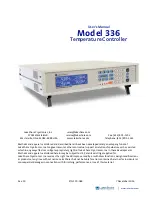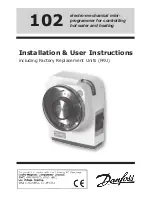
193111-047
TROUBLESHOOTING
8-6 March 1, 2001
8.09
With no battery connected to the charger, press all of the keys on the keypad and the display should indicate that
the button did function. The only exception will be the Equalize and Stop keys. To test them, connect a battery and
allow the charger to start, then press the button. The SCR2000 is shipped set for automatic equalize which means
unless this is changed, the equalize button will not respond. To find out if the Status LED’s on the keypad are okay,
press key number “0” and a complete review will occur that starts out by performing a lamp test which lights all the
Status LED’s.
8.10
Temporarily shut down any equipment on the same voltage supply line and see if the control starts to respond
normally. If the control does, then check all grounds going to the equipment that is shut down. If the problems still
exist, then return power to all the other equipment and call your local Prestolite Power Representative.
8.11
Measure the AC supply voltage coming into the charger to confirm that it matches the charge input tap settings.
8.12
Use an Ohmmeter and measure directly across the DC Fuse. A good fuse will measure almost (0) Ohms and a bad
one will measure a very high resistance, in the megohm range or greater. If for some reason a DC fuse measures
somewhere in between, replace the DC fuse and send it in to your local Prestolite Power Representative.
8.13
Refer to the DIAGRAM chapter in the owners manual and locate the diagram for your charger to determine where the
output cables connect to the charger. The black (Negative) output cable goes into the charger and connects to a bus
bar on the end of the DC fuse which is located on the left portion of the interior panel. The red (Positive) output cable
goes into the charger and connects to the heat sink in the back of the charger. The output connector will have a (+)
and (-) symbol on it. The (+) terminal should have the red output cable connected to it, and the (-) should have the
black output cable connected to it.
8.14
Make sure the output connector does not have any cracks on its casing that could result in a short. Make sure the
output cable lugs are making a good connection with the battery connector. You will see traces of pitting on the lug
surface from arcing if there isn’t a good connection. This could be the result of a weak retainer clip in the connector
or lugs that were soldered on incorrectly. If the lugs had too much heat applied to them when the cables were
soldered on, the solder will wick up the cable and make it very stiff. When they are inserted into the connector, the
stiff cable forces the retainer clip down and creates poor connection between the battery connector and the charger
connector.
8.15
Do a continuity or resistance test. Check for connection points that visually appear to have been exposed to
extreme heat. Any connections that appear loose or overheated must be re-lugged and rechecked.
8.16
To check expansion board for proper operation, first make sure there is a good connection to the main SCR2000
board. Remove the control and inspect, the connector is located in the lower right of the PC boards. Check for the
proper I.D. number in function #37 (See “Programming Your SCR2000 Control” chapter in this manual). Also check
the CDAC cables for proper insertion or damage.
If the interface to CDAC still does not work after these checks and if any of the voltage measurements are incorrect,
replace the expansion PC board.
8.17
Specific Gravity readings vary with the temperature of the electrolyte. To temperature correct the readings to match
the nameplate ratings of the battery, use the following rule of thumb: +1 S.G. point per 3 degrees F. increase of the
electrolyte temperature from 77 degrees F.
8.18
Take “Specific Gravity” readings and measure “Cell Voltages”. If acid has been spilled or the battery has been
extremely heated, it is possible that a battery’s capacity could be greatly reduced, and the acid is not capable of
increasing to the battery nameplate rating.
8.19
The proper equalize schedule is one that is tailored to the specific battery and charger operation. The SCR2000
auto equalize feature can be used to automate the equalize schedule (see the “SCR2000 Control Features” chapter
of this manual).
Excess equalizing causes increased water usage. Too little or no equalizing can lead to battery sulfation and/or
decrease battery shift run times. Adjusting the auto equalize number of cycles to can improve the equalize
performance (see the “Programming Your SCR2000 Control” chapter of this manual). Some operations may also
benefit from day of week equalizing. This can be programmed by the AUTO EQ type function to the SCR2000
Control (see the “Programming Your scr2000 Control” chapter of this manual).





































